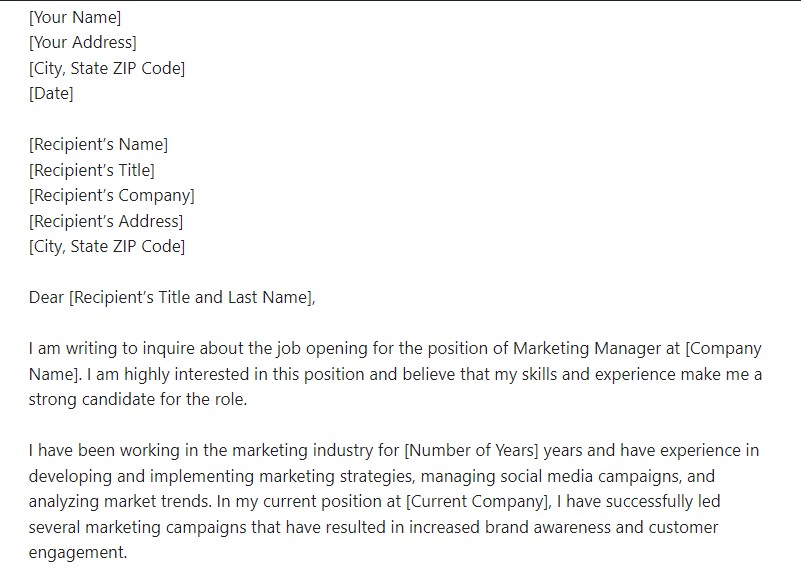Formal letters are used for professional correspondence in various settings such as business, academia, government, and legal matters. Here are some tips and examples to help you write a successful formal letter.
Here are some frequently asked questions about formal letters:
What is a formal letter?
A formal letter is a type of written communication that follows a professional format and tone. It is often used in business, government, and academic settings.
What is the purpose of a formal letter?
The purpose of a formal letter is to convey a message in a clear, concise, and professional manner. Formal letters are used to request information, make requests, complain, make inquiries, provide feedback, and communicate important information.
What is the format of a formal letter?
The format of a formal letter typically includes a heading, date, recipient address, salutation, body, closing, and signature. The body of the letter is organized into paragraphs, and each paragraph should address a specific topic.
What is the difference between a formal letter and an informal letter?
Formal letters follow a professional format and tone and are used in professional settings. Informal letters are more casual and personal, and are used in non-professional settings such as personal correspondence.
What should I include in a formal letter?
A formal letter should include a clear and concise purpose, supporting details, and a polite and professional tone. It should also be well-organized, free from errors, and provide contact information for follow-up.
What should I avoid in a formal letter?
When writing a formal letter, avoid using slang or casual language, being too informal, or using an aggressive or confrontational tone. Also, avoid making spelling and grammar mistakes, and ensure that the letter is well-organized and easy to read.
What are some tips for writing an effective formal letter?
To write an effective formal letter, be clear and concise, use a professional tone, and organize your thoughts logically. Avoid using jargon or technical terms that the reader may not understand, and make sure to proofread the letter before sending it. Finally, make sure to follow up with the recipient if necessary.
Here are the steps to follow when writing a formal letter:
1. Choose a professional format: Formal letters should follow a professional format that includes a heading, date, recipient address, salutation, body, closing, and signature. You can find templates online or use the standard format as a guide.
2. Address the recipient: Begin the letter with a formal salutation such as “Dear Mr./Ms. Last Name” or “To Whom It May Concern.” If you know the recipient’s name, use it, but be sure to spell it correctly and use the appropriate title.
3. Introduce yourself and the purpose of the letter: In the first paragraph, introduce yourself and the purpose of the letter. Be clear and concise, and state the reason for writing the letter.
4. Provide supporting details: In the body of the letter, provide supporting details to back up your purpose. Use clear and concise language, and organize your points logically.
5. End the letter politely: In the closing paragraph, summarize the purpose of the letter and express appreciation for the recipient’s attention. Use a formal closing such as “Sincerely,” “Yours truly,” or “Best regards,” followed by your signature and printed name.
6. Proofread the letter: Before sending the letter, proofread it carefully for grammar, spelling, and punctuation errors. Make sure that all information is accurate and up-to-date.
7. Send the letter: Once you’re confident that the letter is error-free and conveys the message you want to send, send it through the appropriate medium such as email, mail or fax.
Remember, formal letters are a form of professional communication, so it is important to maintain a polite and respectful tone throughout the letter.
Here is a sample of a formal letter:
[Your Name]
[Your Address]
[City, State ZIP Code]
[Date]
[Recipient’s Name]
[Recipient’s Title]
[Recipient’s Company]
[Recipient’s Address]
[City, State ZIP Code]
Dear [Recipient’s Title and Last Name],
I am writing to inquire about the job opening for the position of Marketing Manager at [Company Name]. I am highly interested in this position and believe that my skills and experience make me a strong candidate for the role.
I have been working in the marketing industry for [Number of Years] years and have experience in developing and implementing marketing strategies, managing social media campaigns, and analyzing market trends. In my current position at [Current Company], I have successfully led several marketing campaigns that have resulted in increased brand awareness and customer engagement.
I am impressed with [Company Name]’s reputation in the industry, and I would be honored to contribute my skills and expertise to the team. I am excited about the prospect of working with a company that is known for its innovation, creativity, and commitment to excellence.
Please find attached my resume and a list of references for your review. I would be happy to provide additional information or answer any questions you may have. Thank you for considering my application. I look forward to hearing from you.
Sincerely,
[Your Signature]
[Your Typed Name]
In this sample letter, the writer uses a formal tone and structure to express their interest in a job opening. They provide details about their skills and experience and express admiration for the company. The letter ends with a polite and professional closing, inviting the recipient to reach out for additional information or clarification.
